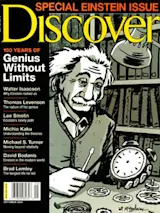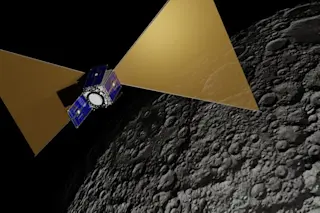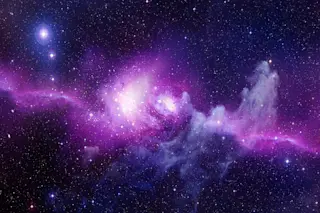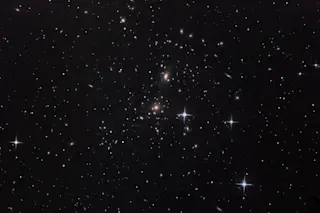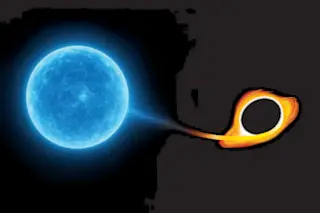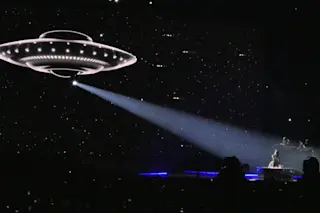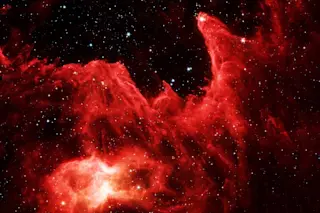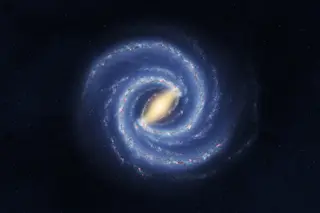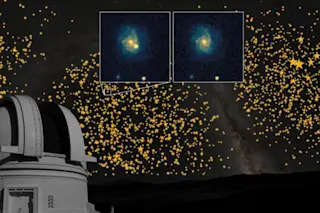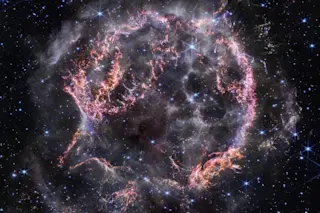Einstein didn’t care much about experiments. Of the three tests he proposed for general relativity, the first—that clocks should tick slower in a gravitational field—wasn’t satisfied until after his death. Early experiments tended to contradict the prediction. His second prediction, that light from distant stars would be deflected by the warped space-time around the sun, catapulted him to world fame in 1919, when observations of a solar eclipse seemed to confirm his prediction. But as historians have since shown, the 1919 measurements were equivocal at best.
The one unequivocal verification of Einstein’s theory during his lifetime was his explanation of a tiny anomaly in the orbit of Mercury. When he finally got that calculation to work, that was the only evidence he needed that space and time really were warped. “Nature had spoken to him,” wrote biographer Abraham Pais. “He had to be right.”
We now know he was. Just last year, for instance, radio signals transmitted from the Cassini spacecraft on its way to Saturn proved to be deflected by the sun by just the amount predicted by general relativity. Einstein would have been unimpressed. He believed his theory was correct because it was consistent, simple, and beautiful. “It is my conviction that pure mathematical construction enables us to discover the concepts and the laws connecting them, which give us the key to the understanding of the phenomena of Nature,” he declared in 1933.
For better and worse, this aspect of Einstein’s approach to physics is very much alive today: “Pure mathematical construction” is an industry that employs hundreds of workers. What they have been trying to construct is a unified theory of the four forces—gravity, electromagnetism, and the strong and weak nuclear forces. To build that, they first have to find a way of describing gravity, not in Einsteinian terms as a curvature of space-time but like the other three forces, as an exchange of force-bearing quanta. This quantum gravity theory would take over from general relativity in the extraordinarily tight quarters—the very core of a black hole, the very instant of the Big Bang—where relativity now predicts, absurdly, that space-time is infinitely curved. The final unified theory, in turn, would gratify most physicists’ deep belief that the four forces really were equivalent once, in the first nanosecond after the Big Bang. That idea “is so beautiful that it has to be that way,” explains physicist Clifford Will of Washington University. “That’s an Einsteinian point of view.”
Sure enough, there is as yet no experimental evidence to support this view—indeed, the improbability of ever reproducing black holes or big bangs in the laboratory has caused some researchers to wonder whether there will ever be any evidence. “Since the middle 1970s we’ve been in a situation in fundamental physics in which theory has run on, largely unchecked by experiments,” says Lee Smolin, a theoretical physicist at the Perimeter Institute near Toronto. (Smolin’s article on Einstein and his scientific legacy begins on page 36.) “And most of us think this has been very bad.”
But lately Smolin and others have been finding grounds for optimism: The reign of the theorists seems to be coming to an end. The several schools of quantum gravity, physicists have realized, are slowly reaching consensus that incremental violations of relativity might be detectable even outside a black hole, and without building a particle accelerator the size of the universe. For that reason, and also because experimenters like to poke at the marble facades of grand theories, Einstein’s ideas are being tested with increasing frequency these days and to extraordinary precision. What follows is a sampling of these experiments—just a few of the many now under way or on the drawing boards.
“I do not consider the main significance of the general theory of relativity to be the prediction of some tiny observable effects,” wrote Einstein in 1930. Nonetheless, it was tiny observable effects that eventually proved that in certain situations Newton’s physics needed to be replaced by Einstein’s. In the same way it will be tiny observable effects that will one day prove where the limits of Einstein’s genius lie. “People sometimes ask, ‘Why have you felt you should persist in this way to perform a test of Einstein?’ ” says Stanford University physicist Francis Everitt, one of the leaders of a satellite experiment called Gravity Probe B, which was launched in April. “Aren’t Einstein’s theories all established and confirmed? After all, it’s a hundred years ago that he developed his first theory of relativity. Don’t we already know it all? And the answer is no.” Some of the most important experiments under way may answer the questions that follow.
IS THE SPEED OF LIGHT CONSTANT?
Late in life Einstein couldn’t even remember whether he’d been aware, in 1905, of the Michelson-Morley experiment, which showed that the speed of light is constant in all directions. Although we now think of the experiment as having shattered absolute space and time, that result was not at all what Albert Michelson and Edward Morley expected when they did their experiment in 1887, in a basement of the Western Reserve University in Cleveland. They were trying to detect variations in the speed of light to prove the existence of the “luminiferous aether,” a perfectly immobile, transparent, and mysterious substance that was thought to pervade the universe. Physicists had conceived of the ether as a medium that could transmit light waves, the way air or water transmits sound. The ether had to exist, but no one had seen it—it was a bit like dark matter today.
Because Earth orbits the sun at 18 miles per second, Michelson and Morley reasoned that they should be able to detect an ether wind blowing through their Cleveland basement with the help of an experimental setup called an interferometer. They split a light beam in two with a half-silvered mirror, sent the two halves of light off at right angles, and then bounced them off mirrors about five feet away. The two men expected that light waves traveling against the ether wind, in the same direction as Earth’s motion, would be slowed and would arrive back at the starting point slightly later than the light waves traveling across the wind. When the two beams were recombined, the offset waves would interfere with each other to produce a distinctive pattern of light and dark bands. Michelson and Morley made their measurements with extraordinary care but saw no disruption in the pattern—the light beams traveled the same speed in all directions, impervious to any ether wind.
One null result, of course, did not rid the universe of the ether. Michelson went to his grave in 1931 convinced that it had to exist. But by then Einstein had changed most people’s minds and persuaded them to accept the simple, beautiful truth: The velocity of light, c, really is different from any other velocity. Anyone who measures the speed of any light beam—or any other type of electromagnetic radiation—will get the same value for c: 299,792,458 meters per second. There is no absolute space, Einstein decided, ether-filled or otherwise. Seen in that light, the Michelson-Morley result made perfect sense.
And yet today theorists are questioning the absoluteness of c. Some versions of string theory, the most popular candidate for a unified theory, say there could be extremely feeble force fields left over from the Big Bang that point in different directions in different parts of space. An experiment to measure c might produce variations depending on how the setup was oriented with respect to one of those fields, variations far smaller than Michelson and Morley could have detected.
Several groups are looking for such variations with modern versions of the Michelson-Morley experiment. Peter Wolf, Sebastien Bize, and their colleagues at the Paris Observatory measure c with microwaves oscillating at 12 gigahertz inside a small sapphire crystal. Microwaves reflecting back and forth within the crystal line up and reinforce each other, or resonate—as long as they are moving precisely at c. If c were to change because the orientation of the crystal had changed with respect to some “preferred” direction of space, then the resonant frequency of the sapphire oscillator would change as well. The apparatus containing the crystal is bathed in liquid helium, chilling it to a few degrees above absolute zero to make sure that the crystal doesn’t expand or contract by even a femtometer.
Over a period of months, as Earth spins on its axis and revolves around the sun, the Paris researchers monitor their oscillator, comparing it with the microwaves from a hydrogen maser (microwave laser), which shouldn’t be affected by Earth’s motion. “What we measure is that small frequency difference,” says Bize. “We look for modulations that correlate with the motion of Earth.”
Another group, based at Humboldt University in Berlin, uses a slightly different setup, comparing the outputs of a pair of sapphire oscillators. Over the past several years the two groups have achieved broadly comparable null results. “The speed of light in any two directions is the same to about one part in a quadrillion,” says Holger Müller, a former member of the Berlin team who now works at Stanford. That’s equivalent to knowing the U.S. gross national product to within a penny.
Over vast distances, even such slight variations could become meaningful. If two photons differed that much in velocity, and if they left a galaxy a billion light-years away at the same instant, they would arrive at Earth 30 seconds apart. A few years ago physicist Giovanni Amelino-Camelia at La Sapienza University in Rome had an idea for staging just such a race to test the constancy of c in a new way. Some theories of quantum gravity require space-time itself to be grainy—to be made up of discrete quanta, presumably around 10^-35 of a meter across because that’s the scale at which Einstein’s field equations generate their bothersome infinities. (A proton is a hundred million trillion times bigger.) Amelino-Camelia calculated that light photons might navigate this cosmic foam at slightly different speeds, depending not on their direction—the possibility the Michelson-Morley experiments test for—but on their energy.
In 2007 or so, NASA plans to launch GLAST, the Gamma Ray Large Area Space Telescope. Its main purpose is to allow astronomers to study such events as gamma-ray bursts, which are mysteriously powerful explosions in distant galaxies. But it could also serve as Amelino-Camelia’s finish line. All the photons in a burst, he reasons, must leave the starting blocks at about the same time. If you compare a lot of high-energy photons with a lot of relatively low-energy ones, you should find that on average, after a billion-year race, the high-energy ones reach GLAST’s detector sooner—by about a millisecond. He and other quantum gravity theorists are pretty excited by that possibility, which just goes to show what they’re up against.
WAS EINSTEIN RIGHT ABOUT FREE FALL?
In 1907, sitting at his desk in the patent office in Bern, Switzerland, Einstein imagined himself jumping off a house and realized that while falling he wouldn’t feel his weight. It would have been more poetic to choose the Tower of Pisa for his thought experiment: Galileo, in his own legendary experiments there—truly legendary, because he probably never actually did them—had shown that objects of different mass and composition are equivalent in that they undergo the same gravitational acceleration. If they are dropped at the same time, they should hit the ground at the same time. Einstein took Galileo’s equivalence principle much further. Einstein realized that if a freely falling physicist dropped something, it would stay right next to him. The falling man would have no way of telling (if he closed his eyes) that he was falling, no awareness of gravity at all; that would also go for every instrument in the lab he brought with him. Einstein eventually concluded that gravity was a curvature of space-time, not something that emanated from the masses themselves.
But was Galileo himself right? Newton, among others, tested the equivalence principle. Apparently unbeknownst to Einstein in 1907, a Hungarian baron named Roland von Eötvös had recently completed updated, highly accurate tests using a device called a torsion pendulum. Modern versions of the Eötvös experiment continue to this day in a number of labs. Apollo 15 commander David Scott carried out a less accurate but far more colorful demonstration at the end of his last moonwalk in 1971, when he dropped a geologist’s hammer and a falcon feather from shoulder height. A live TV audience watched them hit the airless moon at the same time. After the Apollo missions, physicists on Earth started bouncing laser beams off reflectors that the astronauts had left on the moon, measuring the Earth–moon distance with increasing precision. Although Earth and the moon are made of different stuff—the moon lacks an iron core—the measurements so far reveal that they are “falling” toward the sun with exactly the same acceleration.
Lunar laser ranging and the modern Eötvös experiments have confirmed the equivalence principle to within less than one part in a trillion. Pierre Touboul, a physicist at ONERA, the French aerospace research agency, thinks he can do a hundred to a thousand times better. Touboul is the project scientist for MICROSCOPE, a microsatellite to be launched in 2007 by the European Space Agency. Its purpose is to conduct Galileo’s free-fall experiment in space, with test masses of different composition. In space, Touboul explains, you don’t need to worry about tiny fluctuations in the gravitational field outside your lab that might throw off your results. Like the moon, orbiting test masses fall for a long time, allowing you to drown out noise with data.
The test masses on MICROSCOPE will be two concentric cylinders of titanium and platinum. (A control experiment will use two platinum cylinders.) The cylinders will be sandwiched between electrodes of gold-plated silicon but also separated from them by thin spaces of vacuum—the test masses will float on the electrodes’ electrostatic field. Loose lengths of wire five micrometers wide, which will remove any electric charge delivered by cosmic rays, will be their only physical contact with the rest of the satellite. Thrusters on the satellite will compensate for the small drag exerted by the outer wisps of the atmosphere. The only force the test masses will feel is Earth’s gravity. Any differences in the electrostatic field needed to keep them in the same orbit will be supplied by the electrostatic levitation.
Instead of trying to determine whether the two masses fall differently, one dipping toward Earth slightly more, Touboul explains that it is easier and more precise to measure the electrostatic forces required to maintain them at exactly the same orbit. The forces are just a function of the current supplied to the electrodes. “If the forces are identical, there’s no violation of the equivalence principle,” says Touboul. MICROSCOPE will keep the test mass orbits identical to within 100 billionths of a meter, or a tenth the width of an atom. That should allow it to detect violations of the equivalence principle down to one part in a quadrillion. Some string theorists have predicted bigger violations than that.
“From a scientific point of view, finding no violation is just as interesting as finding one,” Touboul says. “But my innermost conviction is that there will certainly be a violation. We just don’t know at what level.”
DOES EARTH WARP AND TWIST SPACE-TIME?
Eight years before he completed general relativity, Einstein made a weird prediction: Gravity should slow the passage of time and stretch light waves toward the red end of the spectrum. For years people tried and failed to see this gravitational redshift in the spectrum of sunlight. It wasn’t precisely confirmed until 1976, when a Scout D rocket carried a hydrogen-maser clock to an altitude of 10,000 kilometers, or about 6,000 miles. In the two hours before it plunged into the Atlantic a thousand miles east of Bermuda, the rocket’s timekeeping was compared with that of an identical clock on Earth. A hydrogen maser emits microwaves at 1.42 gigahertz; at the rocket’s apogee the clock on board was about one hertz faster than its terrestrial twin. Einstein was vindicated at last, with a precision of a few parts in a hundred thousand: The stronger the gravity, the slower the clock.
That mission was called Gravity Probe A. Since then atomic clocks have progressed tremendously, and a European mission called ACES, for Atomic Clock Ensemble in Space, may put one on the space station in 2007. Its laser-cooled cesium clock is supposed to measure the gravitational redshift 25 times more precisely than Gravity Probe A; at the altitude of the space station, it should gain about a second in 700 years. And last April NASA finally launched Gravity Probe B, which had been on the drawing boards since 1961. It is designed to measure the curvature of space-time and how the spinning Earth affects it.
The bulk of Gravity Probe B is a thermos filled with 645 gallons of liquid helium. At its heart are four absurdly sensitive gyroscopes. Each one is a quartz sphere the size of a Ping-Pong ball, smooth to within a millionth of an inch and coated with the metal niobium, which is superconducting at liquid helium temperatures. As the sphere floats in an electrostatic field and spins at 10,000 revolutions per minute, a current in the niobium will generate a magnetic field that will be perfectly aligned with the sphere’s otherwise invisible spin axis—and be measurable by sensitive detectors.
By early summer the satellite’s telescope had locked onto a distant guide star, IM Pegasi; all four spheres are now being aligned with this star. For the next year the Gravity Probe B team, led by Francis Everitt of Stanford, will monitor the spheres to see if the warp or drag of space tilts their spin axes out of alignment. “It’s going to be a very dull experiment,” Everitt says.
Yet it has been a somewhat controversial one. The mission didn’t seem worth its $700 million cost to some physicists, who felt that during its 40-year gestation Gravity Probe B had been overtaken by other research. The measurement of space curvature made with the Cassini spacecraft, for instance, is already several times more accurate than Gravity Probe B’s stated goal of 0.01 percent accuracy. (Everitt’s team hopes to exceed that.)
But Gravity Probe B will also do something more important. It will quantify how the spinning Earth stirs space-time like molasses—a relativistic effect called frame dragging that has never been measured directly. Around Earth the phenomenon is a curiosity; to see it, Everitt’s team will have to detect a deflection of their gyroscope axes of only 42 thousandths of an arc second. (That’s an angle, the team’s literature explains, the width of a human hair seen at a distance of a quarter mile.) Around spinning black holes, however, frame dragging could be hugely important: By whipping magnetic field lines through the electrically charged gas around the holes, it could convert them into electromagnetic generators, which would explain how they spew jets of energetic particles millions of light-years into space. “What Gravity Probe B will do for us is verify for the first time that this effect exists,” says Caltech gravitational theorist Kip Thorne. It will also verify if general relativity can accurately predict the magnitude of the effect.
DO GRAVITATIONAL WAVES ROIL THE UNIVERSE?
If you need any proof of the complete faith modern physicists have in relativity, you can find it in Livingston, Louisiana. Or in Hanford, Washington. Or outside Pisa, Italy. In all those places physicists have built novel observatories costing hundreds of millions of dollars each, with arms extending several miles in perpendicular directions. The observatories are designed to detect a kind of radiation that has never been observed but that general relativity tells the physicists must exist: gravitational waves.
Gravitational waves are ripples in the space-time sea; Einstein predicted that they should exist as early as 1916. They spread out in all directions when something massive in the cosmos makes a big splash. The best sources physicists can think of are two black holes or two neutron stars spiraling toward each other and then colliding. In fact, although no one has seen a gravitational wave, a Nobel Prize has already been awarded for work that demonstrates their reality. Astronomers Joseph Taylor and Russell Hulse showed that two orbiting pulsars—neutron stars that emit beams of radiation as they spin—are slowing down by an amount that corresponds exactly to the energy that relativity predicts they should be emitting as gravitational waves. Still, it would be nice to detect a wave. “It would close the books,” says physicist Peter Saulson, who works on the two American observatories, which are called LIGO, for Laser Interferometer Gravitational Wave Observatory. “It’s a sanity check.”
The observatories now coming online—the two LIGOs are operating but still debugging; the European one, VIRGO, will turn on next year—are all Michelson interferometers. An infrared laser beam is split in two; one half travels down one two-and-a-half-mile vacuum tunnel, and the other half travels down a second tunnel at a right angle to the first. Each beam reflects off a mirror at the end of the tunnel and returns to the starting point, where the two beams interfere. Changes in the interference pattern, which Michelson had hoped would show variations in the speed of light, now serve to indicate changes in the length of the beams. These changes, scientists predict, will be caused by a gravitational wave that stretches and squeezes space-time as it passes through the instruments. The observatories are designed to detect changes as small as a hundred millionth the size of a hydrogen atom. A gravitational wave is so difficult to distinguish from other vibrations that physicists won’t believe in a wave’s existence unless at least two observatories see the same minuscule shift.
If they do see some waves, they will be able to test general relativity in several ways. Relativity predicts exactly how much stretching and squeezing a gravitational wave should do. It predicts that gravitational waves should travel at the speed of light. It predicts in some detail the space-time turbulence that would result when two black holes collide.
The problem is, no one really knows how often such events occur. The observatories are designed to be sensitive to waves from as far away as the Virgo cluster of galaxies 65 million light-years away. But that may not be enough of a range. Even before LIGO reaches its design sensitivity, its leaders have requested funding to make it 10 times more sensitive still. On the other hand, physicists are confident enough of eventual success that they have persuaded NASA and the European Space Agency to start planning for LISA, for Laser Interferometer Space Antenna, a space-based interferometer consisting of three satellites, now tentatively scheduled for launch in 2012.
The first detection of a gravitational wave, says Clifford Will, “will be an exciting moment. It will legitimize this whole thing.”
WILL WE FIND THAT EINSTEIN GOT RELATIVITY JUST A WEE BIT WRONG?
It’s just a matter of time, most physicists think, before Einstein fails. Relativity touches so much of physics that a violation could show up almost anywhere. In addition to all the experiments already mentioned, it might come from quasars in the far reaches of the universe. A team of astronomers led by John Webb of the University of New South Wales has been measuring how the light from quasars is absorbed by gas clouds that lie between them and us but are still billions of light-years away, and thus did their absorbing billions of years ago. The frequencies of light absorbed by an atom are governed by a physical property called the fine-structure constant. By comparing their gas cloud data with equivalent measurements made in laboratories on Earth, Webb and his colleagues have hypothesized that the fine-structure constant today is about a thousandth of a percent larger than it was 8 billion years ago. If so, that would clearly violate the equivalence principle—the laws of physics are not supposed to change over time. Recently, though, another team of astronomers failed to confirm Webb’s observations. The jury is still out.
A violation of relativity may also show up in observations of cosmic rays, the energetic particles that bombard Earth from all directions. Calculations based on special relativity predict that ultrahigh-energy cosmic rays should reach Earth only rarely, because they lose energy in space. A Japanese observatory has seen more than expected, and theorists such as Amelino-Camelia think this excess might be the first evidence of a space-time graininess that would ease the passage of high-energy particles. A more powerful observatory now beginning work in Argentina may resolve the issue.
Finally, there’s that nagging little question of what the universe is made of. The concept of dark matter has been around so long now, and the idea that it makes up much of the universe has been repeated so often that one might almost forget that it has never been detected. One of the main reasons people believe that galaxies have halos of dark matter is that the galaxies rotate faster in their outer reaches than the gravity exerted by their visible matter would seem to permit. But an alternative theory, called modified Newtonian dynamics, or MOND, does an even better job of explaining galaxy rotation by simply tinkering with Newton’s law of gravitation—and thus with Einstein’s.
It’s an ugly fix, and unlike dark matter it’s not connected to a larger theory of particle physics, so theorists don’t like it. And yet, says Lee Smolin, “a growing number of people from different specialties are telling me they are waking up in the middle of the night worrying about how well MOND does. I hope the dark-matter models in the end do better. If not, we are seeing massive violations of the Einstein equations right in front of us.”
Wouldn’t that be fun? Wouldn’t it be fun, in fact, to see the old clown-haired saint taken down a nano-peg by a few tiny observable effects? Maybe we’d hear a bit less of that “subtle is the Lord” and “God does not play dice” nonsense. “There are two kinds of psychology in physics,” says Saulson. “One is people who love order and beauty and hope the theories are right. The other is people who think theorists are full of baloney and who hope we’ll find something amazing when we turn on our experiments.” With a little luck, the second group is about to have its turn.


